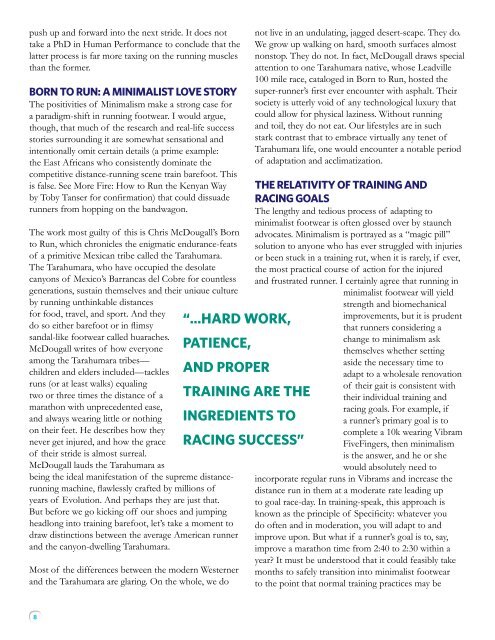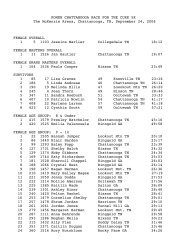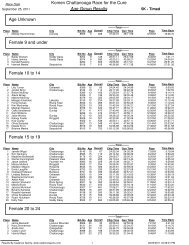Jogging Around - April 2011 - Chattanooga Track Club
Jogging Around - April 2011 - Chattanooga Track Club
Jogging Around - April 2011 - Chattanooga Track Club
You also want an ePaper? Increase the reach of your titles
YUMPU automatically turns print PDFs into web optimized ePapers that Google loves.
push up and forward into the next stride. It does not<br />
take a PhD in Human Performance to conclude that the<br />
latter process is far more taxing on the running muscles<br />
than the former.<br />
BORN TO RUN: A MINIMALIST LOVE STORY<br />
The positivities of Minimalism make a strong case for<br />
a paradigm-shift in running footwear. I would argue,<br />
though, that much of the research and real-life success<br />
stories surrounding it are somewhat sensational and<br />
intentionally omit certain details (a prime example:<br />
the East Africans who consistently dominate the<br />
competitive distance-running scene train barefoot. This<br />
is false. See More Fire: How to Run the Kenyan Way<br />
by Toby Tanser for confirmation) that could dissuade<br />
runners from hopping on the bandwagon.<br />
The work most guilty of this is Chris McDougall’s Born<br />
to Run, which chronicles the enigmatic endurance-feats<br />
of a primitive Mexican tribe called the Tarahumara.<br />
The Tarahumara, who have occupied the desolate<br />
canyons of Mexico’s Barrancas del Cobre for countless<br />
generations, sustain themselves and their unique culture<br />
by running unthinkable distances<br />
for food, travel, and sport. And they<br />
do so either barefoot or in flimsy<br />
sandal-like footwear called huaraches.<br />
McDougall writes of how everyone<br />
among the Tarahumara tribes—<br />
children and elders included—tackles<br />
runs (or at least walks) equaling<br />
two or three times the distance of a<br />
marathon with unprecedented ease,<br />
and always wearing little or nothing<br />
on their feet. He describes how they<br />
never get injured, and how the grace<br />
of their stride is almost surreal.<br />
McDougall lauds the Tarahumara as<br />
being the ideal manifestation of the supreme distancerunning<br />
machine, flawlessly crafted by millions of<br />
years of Evolution. And perhaps they are just that.<br />
But before we go kicking off our shoes and jumping<br />
headlong into training barefoot, let’s take a moment to<br />
draw distinctions between the average American runner<br />
and the canyon-dwelling Tarahumara.<br />
Most of the differences between the modern Westerner<br />
and the Tarahumara are glaring. On the whole, we do<br />
8<br />
“...HARD WORk,<br />
PATIENCE,<br />
AND PROPER<br />
TRAINING ARE THE<br />
INGREDIENTS TO<br />
RACING SUCCESS”<br />
not live in an undulating, jagged desert-scape. They do.<br />
We grow up walking on hard, smooth surfaces almost<br />
nonstop. They do not. In fact, McDougall draws special<br />
attention to one Tarahumara native, whose Leadville<br />
100 mile race, cataloged in Born to Run, hosted the<br />
super-runner’s first ever encounter with asphalt. Their<br />
society is utterly void of any technological luxury that<br />
could allow for physical laziness. Without running<br />
and toil, they do not eat. Our lifestyles are in such<br />
stark contrast that to embrace virtually any tenet of<br />
Tarahumara life, one would encounter a notable period<br />
of adaptation and acclimatization.<br />
THE RELATIVITY OF TRAINING AND<br />
RACING GOALS<br />
The lengthy and tedious process of adapting to<br />
minimalist footwear is often glossed over by staunch<br />
advocates. Minimalism is portrayed as a “magic pill”<br />
solution to anyone who has ever struggled with injuries<br />
or been stuck in a training rut, when it is rarely, if ever,<br />
the most practical course of action for the injured<br />
and frustrated runner. I certainly agree that running in<br />
minimalist footwear will yield<br />
strength and biomechanical<br />
improvements, but it is prudent<br />
that runners considering a<br />
change to minimalism ask<br />
themselves whether setting<br />
aside the necessary time to<br />
adapt to a wholesale renovation<br />
of their gait is consistent with<br />
their individual training and<br />
racing goals. For example, if<br />
a runner’s primary goal is to<br />
complete a 10k wearing Vibram<br />
FiveFingers, then minimalism<br />
is the answer, and he or she<br />
would absolutely need to<br />
incorporate regular runs in Vibrams and increase the<br />
distance run in them at a moderate rate leading up<br />
to goal race-day. In training-speak, this approach is<br />
known as the principle of Specificity: whatever you<br />
do often and in moderation, you will adapt to and<br />
improve upon. But what if a runner’s goal is to, say,<br />
improve a marathon time from 2:40 to 2:30 within a<br />
year? It must be understood that it could feasibly take<br />
months to safely transition into minimalist footwear<br />
to the point that normal training practices may be




